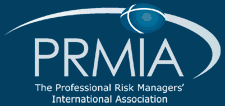Professional Risk Managers' International Association
The Professional Risk Managers' International Association (PRMIA) is a non-profit, member-driven professional organization that focuses on the development and education of the risk management profession. Its membership provides a network of risk professionals working to set standards for the global risk profession. PRMIA offers the Professional Risk Manager designation and several other certification programs for professional certification purposes.[3]
 | |
| Abbreviation | PRMIA |
|---|---|
| Formation | 2002 |
| Type | not-for-profit organization |
| Purpose | Risk Management Education and Certification |
| Headquarters | Northfield, Minnesota |
| Coordinates | 44°26′24.55″N 93°11′12″W |
Region served | Worldwide |
Membership | 50,000 |
Official language | English |
| Robert McWilliam | |
| Ken Radigan | |
| Website | www |
| [1][2] | |
Professional Risk Manager
The Professional Risk Manager (PRM) designation is a professional certification offered by PRMIA.[4] The designation was first awarded in 2004. The PRM is an "independent validation" of skills within the financial risk management profession, and professional ethics. The PRM and the FRM offered by the Global Association of Risk Professionals are often compared as being the two definitive risk management designations in the industry.[5][6][7]
PRM Candidates are required to pass four exams:
- Finance theory, financial instruments and financial markets (2 hours)
- Mathematical foundations of risk measurement (2 hours: calculus, matrix- and linear algebra, probability, statistics, and numerical methods)
- Risk management practices (3 hours: risk management frameworks [capital allocation, regulatory capital, economic capital, capital adequacy], operational risk, credit risk, counterparty credit risk, market risk, liquidity risk, FTP, ALM)
- Case studies, PRMIA standards of best practice, conduct and ethics, bylaws (1 hour)
The exams are computer-based and the questions are all multiple choice; the passing grade is 60%. The exams can be taken in any order and must be completed over a period of up to two years; they are offered during four testing windows per year, each of three weeks.[8] Individual exam pass rates are 54% for Exam II, 59% for Exams I and III, and 78% for Exam IV;[9][10] with an overall of just over 65%.[9] The PRM program recognizes other professional designations and gives partial credit to "cross-over" candidates, as well as to graduates of select university programs. As of 2020, the above are replaced by two sequential papers, with differing requirements: the first two exams are combined, and the second two.
Minimum experience requirements are:[11] four years without a bachelor's degree; two years for those with bachelor's degrees; no requirements for holders of a relevant graduate degree (i.e. MBA, MSF, MQF etc.) or of an accepted professional designation (CFA, CAIA, CQF, etc.). To maintain the designation holder's are required to complete 20 "Continuing Risk Learning" credits each year, to renew their "Sustaining Membership", and to uphold the professional and ethical standards as defined by the PRMIA Standards of Best Practice, Conduct and Ethics.
Other certificate programs
PRMIA offers various stand-alone certificate programs designed to give a focused and foundational understanding of various areas of risk management.[12] As for the PRM, the passing score for these is 60%. The computerized tests are offered on all business days. To maintain certification one is required to uphold PRMIA’s professional and ethical standards.
- The Associate PRM covers the core risk management concepts in a less mathematical fashion than the PRM, "allowing non-specialists to interpret risk management information and reports".[13] A single 3 hour exam is required; the recommended text is The Essentials of Risk Management (ISBN 0071429662).
- The Operational Risk Manager Certificate prepares managers to "implement risk assessment initiatives, produce risk management information and understand basic modeling techniques". The exam is 2 hours duration. Preparation is the practitioner-authored Operational Risk Manager Certificate Handbook. ORM Online Training is also available.
- The Credit and Counterparty Risk Manager Certificate focuses on a practical understanding of credit risk analysis frameworks within financial institutions. The program is designed to be relevant to credit risk staff, as well as to financial controllers, and compliance and legal officers. The exam is 2 hours duration. Preparation is the Credit and Counterparty Risk Manager Handbook.
- The Market, Liquidity and Asset Liability Management Risk Manager Certificate covers the areas of market risk, liquidity risk, and asset liability management, and similarly focuses on application in financial institutions. The exam is 2 hours duration. Preparation is the Market, Liquidity and Asset Liability Management Risk Manager Handbook.
See also
|
Institutions
|
Certifications
|
References
- "Cause IQ Organization Profile". Professional Risk Managers International Association (PRMIA). Nonprofit Metrics LLC. Retrieved 25 October 2020.
- "Board of Directors". Board of Directors. Professional Risk Managers' International Association. Retrieved 25 October 2020.
- Fisher, Sarah. "What is a Professional Risk Manager (PRM)?". Kake. Kake. Retrieved 25 October 2020.
- Home | Professional Risk Managers' International Association - PRMIA
- Risk Managers Get Certified – As Profession Grows, Demand Increases for Standards-Setting Examinations. (Archived), Wall Street Journal (April 1, 2010)
- Beyond the CFA and MBA, efinancialcareers.com
- The Rise of the Chief Risk Officer, Institutional Investor (March 2017).
- PRM Candidate Guidebook
- FAQs
- prm-exam, wallstreetmojo.com
- prmia.org: Changes to the PRM Exam
- Certificate Programs
- Home | Professional Risk Managers' International Association - PRMIA
